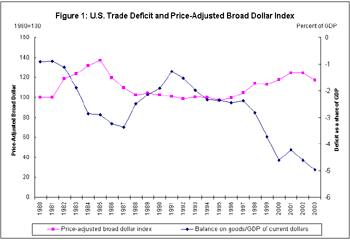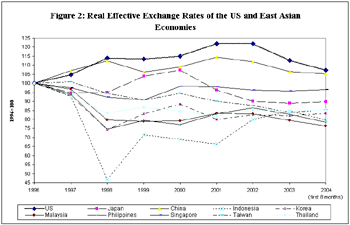The world economy is hanging in a precarious balance. The U.S. is currently running large and unsustainable twin deficits (the budget and trade deficit), both at roughly 5% of GDP (Figure1). On the other side of the equation, the East Asian region is collectively running a large trade surplus with the U.S. and rapidly accumulating foreign exchange reserves, which are then largely returned to the U.S. to finance its budget deficit.
This arrangement will come under great stress if the U.S. economy slows substantially. The recent drop in the U.S. 10-year bond rate to slightly over 4% in spite of three consecutive quarter-point interest rate increases by the Federal Reserve Board indicates that the market has begun to discount the probability of a major economic slowdown after the November presidential election. The U.S. economy, which already peaked earlier this year in an upward election year cycle, will eventually have to make major adjustments given the twin deficits. Although it is uncertain how the adjustment process will play out after the presidential election, one remedy is both fairly clear and fairly likely based on past experience: The dollar will have to depreciate substantially so as to allow the U.S. trade balance to return to a sustainable path. A recent OECD study (see note) shows that it would take a 22.5% decline in the trade-weighted value of the dollar in order for the U.S. current account deficit to fall by one percentage point of GDP. Extrapolating from this, the dollar would have to fall by 45% to return the U.S. trade deficit to a tolerable 3% of GDP.
Obviously, the currencies of East Asia will have to play a major part in this adjustment. Absent a policy change, countries such as China and Malaysia, whose currencies are still pegged to the U.S. dollar, run the risk of encouraging large, speculative, short-term capital inflows, pushing their foreign exchange reserves still higher. The monetary base and domestic credit supply could thus expand rapidly, leading to soaring inflation in these countries. For those economies in the region that have already moved to a flexible exchange rate regime, substantial currency appreciation is likely, which would undercut export competitiveness and, potentially, economic growth. Although in the past year or so the dollar has already declined significantly against the euro, appreciation of the East Asian currencies has been negligible (Figure2). This is because the large capital flows into East Asia have been effectively sterilized as Japan, China, and other economies in the region were on the brink of deflation or rapid disinflation, making the costs of sterilization insignificant.
However, sterilization cannot continue indefinitely. The East Asian region has already accumulated substantial foreign exchange reserves in the past year and accelerating inflation has become a real policy concern. Even Japan, the country most marred by deflation, is contemplating monetary policy options beyond its current zero interest rate policy as its economic recovery gathers strength.
In the meantime, the Bush administration has been pursuing an ill-conceived policy as it attempts to address its trade deficit bilaterally with China alone by trying to jawbone the country into to revaluing the renminbi (RMB). Not surprisingly, the policy has not worked for an obvious reason: The exchange rate issue is traditionally a macroeconomic one and should be discussed by looking at multilateral rather than bilateral trade balances. In addition, China is now at the center of an East Asian trade triangle, importing technology-intensive and sophisticated intermediate goods such as parts and components as well as commodities from Japan, the newly industrialized economies (Korea, Taiwan, Singapore), and the ASEAN countries. Thus, China alone cannot become the world's workshop. Only the East Asian region as a whole can play that role. If the onus of exchange rate adjustment falls on China alone and other countries do not do their part, a "free rider" problem will arise and the U.S.-East Asia imbalance will not be resolved. Moreover, a large one-time revaluation of the RMB would likely create a massive asset price bubble in China, a repeat of Japan's experience after the 1985 Plaza Accord.
The production cum distribution networks established in East Asia underscore the importance of price stability throughout the region. The large trade component of GDP in the region suggests that exchange rate stability remains an important policy objective.
Clearly, the lack of policy coordination experience and the weak financial infrastructure still make it premature for East Asian countries to move toward an EMS- type, mutually-pegged, joint floating with a band. Nevertheless, the region should take the first step toward a negotiated agreement as how much appreciation against the dollar each currency concerned has to undertake. Each country in East Asia should then allow its currency to move within a band set around the new exchange rate level according to its own market and macroeconomic conditions. The band can be set narrowly, for example, plus or minus 5%-6%, for countries with greater policy credibility; for those economies with relatively less policy credibility, the band can be set wider, say, plus or minus 10%-12%. There are three reasons why such a band would be appropriate for and defensible by East Asia: First, the region has traditionally had good macroeconomic fundamentals, which helps instill market confidence. Second, given the lack of adequate legal, regulatory, and informational institutions in the region, the developing East Asian economies such as China can still apply Chilean-type capital controls to reduce volatile short-term capital flows, as a substitute for effective market-based intuitions. Third, the lessons of the Asian financial crisis have shown that the IMF, under the strong influence of the United States, could not act as a global lender of last resort during the capital account crisis that took place in Asia in 1997 because the U.S. Congress rightly realized that U.S. taxpayers' money should not be used to bail out non-U.S. institutions caught in emerging-market crises. Given the limited funds each emerging economy in East Asia can draw on, it is simply impossible for them to stem massive capital outflows. This, in turn, highlights the need for a regional monetary facility specifically aimed at the type of capital account crisis that has strong spillover effects in terms of regional contagion. The region has already started to pool its foreign exchange reserves to prevent such a crisis from recurring. It is only prudent for East Asia to redouble its efforts to strengthen the existing regional swap facility (i.e., the Chiang Mai Initiative) as the region moves to a collective exchange rate adjustment, which is a concrete first step toward closer monetary and exchange rate policy coordination. With further development of regional financial markets and policy coordination mechanisms, it is not difficult to envision a mutually pegged, jointly floating regional exchange regime emerging in the region in the medium term.
Of course, coordinating exchange rate adjustment collectively presents many challenges to policy-makers in East Asia because, at the moment, the region lacks formal institutions for coordinating macroeconomic policies. But it also offers a rare opportunity for these countries to start engaging in intensive policy dialogues on the issue of currency adjustment. Through such policy dialogues and coordination, East Asia may be able to go beyond the existing trade and FDI arrangements and move steadily toward an eventual monetary union.




